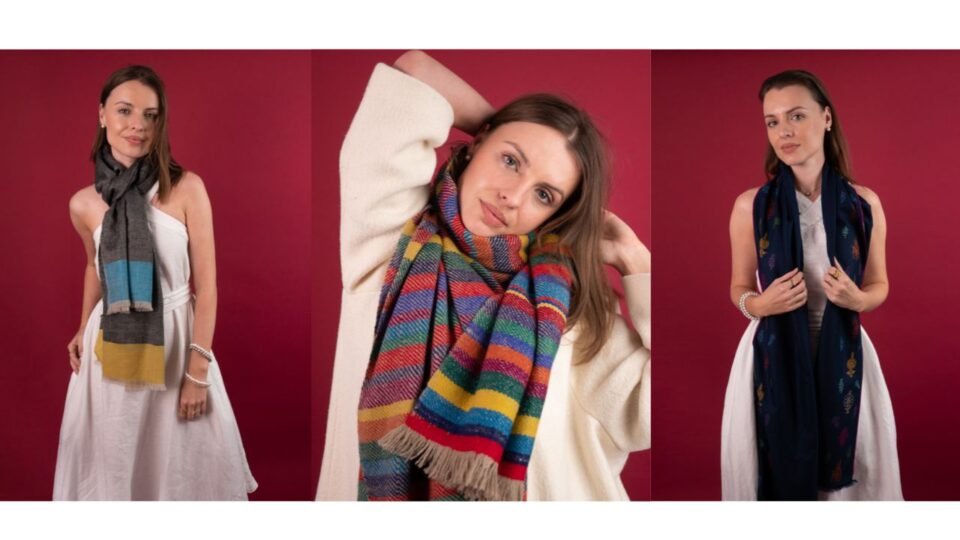Farm to fashion shawls represent more than just luxury and warmth—they are a symbol of sustainability, ethics, and the preservation of age-old traditions. At Aurumere, each shawl tells a story, woven carefully by artisans using responsibly sourced, natural fibers and time-honored techniques passed down through generations.
In a world overrun by fast fashion, Aurumere’s shawl making process stands out for its commitment to ethical shawl production, eco-friendly practices, and the empowerment of artisan communities. In this blog, we take you on a journey—from the farm to your wardrobe—showing exactly how shawls are made the Aurumere way.
The Meaning Behind “Farm to Fashion” Shawls
When we say “farm to fashion shawls,” we mean that every piece begins at the grassroots—literally. From the sourcing of raw wool to the final stitches, the entire process is transparent, traceable, and rooted in sustainability.
This approach ensures:
- Natural, biodegradable materials are used
- Ethical treatment of animals and people
- Preservation of traditional handcrafting techniques
- A reduced carbon footprint from local, small-scale production
Step-by-Step: The Aurumere Shawl Making Process
1. Sourcing Raw Wool from Ethical Farms
It all begins on small family-run farms in India, where sheep are raised humanely and sheared gently by experienced herders. Aurumere sources its wool from regions known for producing soft, warm, and durable fibers—often Himalayan and northern Indian areas where cold weather encourages high-quality fleece.
The wool is:
- 100% natural and untreated with harsh chemicals
- Sourced during the natural molting season (shearing does not harm the animal)
- Collected sustainably to support rural communities
2. Cleaning and Carding
Once the wool is collected, it undergoes a gentle cleansing process using eco-friendly soaps to remove dirt and lanolin without stripping away the fiber’s natural texture. Then, it is carded—a process that aligns the fibers and prepares them for spinning.
3. Hand Spinning
Aurumere proudly supports rural women by training them in hand spinning, where wool is transformed into yarn using traditional wooden charkhas (spinning wheels). This not only provides income to women but also ensures that no electricity or heavy machinery is used—making it an entirely sustainable fashion shawl process.
4. Natural Dyeing
Aurumere uses plant-based dyes sourced from local herbs, roots, and barks to color its yarns. Some of the common natural dyes include:
- Indigo (for deep blues)
- Madder root (for warm reds)
- Turmeric and pomegranate rind (for golden hues)
This chemical-free dyeing process makes each piece skin-friendly, earth-friendly, and uniquely beautiful.
5. Traditional Hand Weaving
Each shawl is woven on a handloom, often in small artisan workshops or family homes. These traditional techniques include intricate patterns and motifs that reflect India’s diverse regional heritage.
Unlike mass-produced machine-made shawls, Aurumere’s handmade shawls from India:
- Are one-of-a-kind
- Have slight variations that celebrate human touch
- Use time-tested weaving methods such as “Kullu,” “Kani,” or “Twill” patterns
6. Finishing and Fringing
Once woven, each shawl is hand-finished with meticulous care. Artisans add fringes, check for consistency, and make sure the fabric feels just right—soft, luxurious, and durable. Only after thorough quality checks does it receive the Aurumere tag.
Why Aurumere Chooses Ethical & Sustainable Shawl Production
At Aurumere, every decision—from sourcing to packaging—is made with the environment and community in mind. Here’s what makes us different:
- Zero waste philosophy: No synthetic dyes, no industrial waste
- Fair wages and safe working environments for artisans
- Slow fashion mindset: Less quantity, higher quality
- Local sourcing and production to reduce transport emissions
By choosing an Aurumere shawl, you’re investing in sustainable fashion shawls that uplift rural economies, preserve handcrafting traditions, and tread lightly on the planet.
From the Loom to You
Each Aurumere shawl passes through over 20 skilled hands before reaching your wardrobe. What you’re wearing is not just an accessory—it’s a legacy of culture, sustainability, and timeless craftsmanship.
Whether you’re gifting it or styling it for yourself, know that you’re wrapped in a story that began with care—on a farm, under the sun, in the hands of real artisans.
Conclusion
In a world increasingly driven by fast fashion, Aurumere’s handmade shawls from India are a rare testament to slow, meaningful craftsmanship. The farm to fashion process ensures that every shawl is rooted in nature, made by skilled hands, and wrapped in integrity.
Looking for a statement piece that feels as good as it looks? Choose a shawl that supports the planet, artisans, and timeless fashion. Choose Aurumere.
Popular Searches
Stoles | Shawls | Embroidered | Limited edition | All Products
FAQs
1. What does “From Farm to Fashion” mean in the context of Aurumere shawls?
It means the entire journey of the shawl—from sourcing raw wool on ethical farms to spinning, dyeing, weaving, and finishing—is done in a sustainable, transparent, and ethical way. Every step supports local artisans and the environment.
2. Where does Aurumere source its wool for shawls?
Aurumere sources wool from small-scale, ethical sheep farms in India, particularly in colder regions like the Himalayas. These farms follow humane practices and produce soft, high-quality fleece.
3. Are Aurumere shawls made from 100% natural fibers?
Yes. All Aurumere shawls are made from 100% natural wool and dyed using plant-based, chemical-free dyes. No synthetic fibers or chemicals are used at any stage.
4. What traditional techniques are used in weaving Aurumere shawls?
Shawls are woven using traditional handloom techniques like Kullu weaving, twill patterns, or Kani motifs—depending on the region. These techniques are passed down through generations and give each shawl a distinct cultural identity.
5. How long does it take to craft one Aurumere shawl?
On average, it takes 10 to 15 days to create one shawl—from shearing the wool to the final finishing. Intricate designs and patterns may take longer, depending on complexity.
